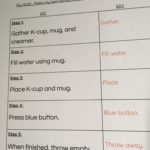On my mind today: Why choose one of the evidence-based therapy tools for treating cognitive challenges? What do they offer, especially when compared to the comfortable, safe options we have in our treatment closets like Rush Hour, card games, worksheets, or workbooks? If the evidence presented in the previous posts hasn’t convinced you, then my final case would be this: FLEXIBILITY. Here’s what I mean:
Let’s take a functional need and compare evidence-based treatment choices to use in speech therapy:
| Treatment Choice: | GOAL: Transferring correctly and safely | GOAL: Ordering food independently at facility |
Goal Management Training |
-Work through Goal-Plan-Do-Review process to improve independent strategy use and safety with transferring (evidence shows this can generalize to multiple locations) | -Work through Goal-Plan-Do-Review process to improve patient’s planning and skills for facility’s ordering food process (Planning could then generalize to other areas such as attending leisure activities) |
| Step-By-Step Activities
|
-Develop 4-step sequence with key words and use step-by-step chaining technique to train patient | -Develop 3 steps necessary to ensure lunch order is complete each day and use chaining technique to train step by step. |
Task-Specific Cognitive & Language Supports |
-Create picture sequence with 2 key words for out of bed transfer
-Add signs by bed and bathroom for reminders to use safe transfer techniques |
-Set alarm to cue patient when to complete 3-step ordering process
-Create personalized favorite foods menu to help patient narrow down choices. |
Spaced Retrieval |
Use spaced retrieval to train reference to written cue card “Lock Brakes” | Use spaced retrieval technique to cue patient to complete written menu choice after breakfast |
Isn’t this awesome? These are just some ideas about how FLEXIBLE the evidence-based cognitive treatments are. The examples above show how each of them could be used to ultimately meet the same goal — obviously as a clinician, you get to choose which method will be most efficient and most likely to work for your patient (See the Cheat Sheet if you haven’t printed this out!)
If you choose to put sentences in order in hopes that this will help sequencing for a transfer: Your plan is to hope and pray that this worksheet skill will generalize (This has not been supported in the evidence).
If you choose to play Rush Hour in hopes that this will improve problem-solving for using a strategy to complete meal orders on time: Your plan is to hope and pray that this skill will generalize (This has not been supported in the evidence).
If you choose to play a card game in hopes that improved attention in the card game will lead to improved attention for locking brakes during a transfer: Your plan is to hope and pray that improving at a card game will generalize to other skills (This has not been supported in the evidence).
Do you see the difference? Using an evidence-based treatment and applying it to a functional need has FLEXIBILITY: You can meet many goals using one of the treatments listed above. It also has evidence support that it can improve a real life skill! I hope you dare to go against the safe, comfortable choices we have in our speech therapy closets, and choose an evidence-based treatment instead this week!
Are you choosing the best options in your therapy time? Purchase Book 1: Goal Management Training, Book 2: Step by Step Activities, Book 3: Task-Specific Language or Cognitive Supports, or Book 4: Spaced Retrieval in my store!
Make sure you get the latest functional therapy updates: Follow Honeycomb Speech Therapy on Facebook , Pinterest, or Instagram, or sign up for email updates below.

These are great resources and as you say they can be generalised to whatever environment you plan to work on